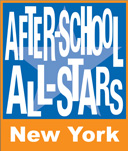Need for After School
The after-school hours provide a uniquely creative and entrepreneurial time in the field of public education. High quality after school programs like After-School All-Stars leverage community resources; provide engaging learning opportunities for kids, address the major issues kids face today, and provide practical solutions for working families in under resourced communities.
The After-School Hours are a Critical time in New York
74% of New York parents believe afterschool reduces the likelihood that kids will engage in risky behaviors. (Afterschool Alliance, 2017)
More than 28 million parents of school-age children are employed, including 23 million who work full time in the U.S. (U.S. Department of Labor, 2010)
Of the 632,076 New York students enrolled in afterschool, another 1.2 Million are waiting to be enrolled. (Afterschool Alliance, 2017)
The hours between 3 and 6 p.m. are the peak hours for juvenile crime and experimentation with drugs, alcohol, cigarettes and sex. (Fight Crime: Invest in Kids, 2003)
After-School Programs Offer a Range of Benefits to Youth and their Families
An analysis of 68 afterschool studies concluded that high quality afterschool programs can lead to improved attendance, behavior and coursework. Students participating in a high quality afterschool program went to school more, behaved better, received better grades and did better on tests compared to non-participating students. (Durlak,Weissberg & Pachan, 2010)
Teens who do not participate in afterschool programs are nearly three times more likely to skip classes than teens who do participate. They are also three times more likely to use marijuana or other drugs, and are more likely to drink,smoke and engage in sexual activity. (YMCA of the USA, 2001)
Parents miss an average of five days of work per year due to a lack of afterschool care. Decreased worker productivity related to parental concerns about afterschool care costs businesses up to $300 billion per year. (Catalyst & Brandeis University, 2006)
Afterschool programs are serving a high need population. The Afterschool Alliance’s 2009 America After 3PM study revealed that an average of 67 percent of kids participating in afterschool programs qualify for free/reduced price lunch, 14 percent are Limited English Proficient and 11 percent have special needs/disabilities.
After-School Programs Support Student Success
The Promising Afterschool Programs Study found that regular participation in high-quality afterschool programs is linked to significant gains in standardized test scores and work habits as well as reductions in behavior problems among disadvantaged students. (University of California at Irvine, 2007)
Annual teacher-reported performance data from 21st CCLC grantees across the country demonstrate that students attending 21st CCLC programs raise their Math grades (37 percent) and English grades (38 percent), while also
improving their homework completion and class participation (72 percent) and their behavior in class (67 percent).(Learning Point Associates, 2010)Researchers at Johns Hopkins University concluded that two-thirds of the achievement gap between lower- and higher-income youth results from unequal access to summer learning opportunities. (American Sociological Review,2007)
After-School Programs Are Seen as Critical and In Demand
A 2008 Afterschool Alliance election eve poll revealed that 3 in 4 voters (76 percent) say afterschool programs are “an absolute necessity” for their community.
According to a 2004 Public Agenda survey, low-income and minority parents are much more likely than higher-income and white parents to say they have trouble finding high-quality, convenient and affordable activities for their children.
According to a 2003 Fight Crime: Invest in Kids poll of working moms, despite public focus on school shootings and
other violence during the school day, nearly 9 in 10 working mothers said they are most concerned about their children’s safety during the afterschool hours.
















.png)
